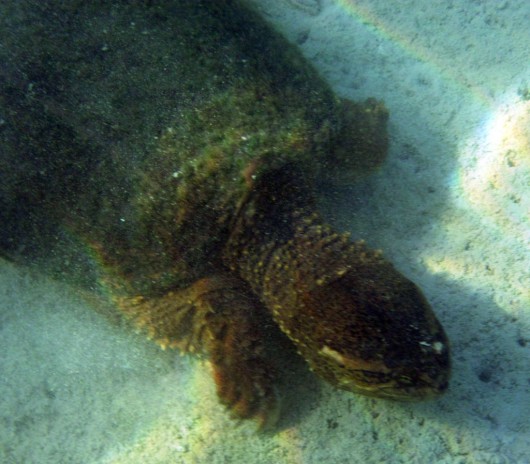Ernie Harwell, the Detroit Tigers Baseball Hall of Fame announcer, began the first spring training broadcast of each season with a reading from the Song of Solomon, King James Version. “For lo, the winter is past, the rain is over and gone; the flowers appear on the earth; the time of the singing of birds is come and the voice of the turtle is heard in our land.” I have no idea why he did that.
I also have no idea about that voice of the turtle part. I’ve read that language scholars say that Old English “turtla” was a derivative of the Latin “turtur” and that the word that the King James translators read as turtle was really turtledove. So, maybe we have a mistake on that voice of the turtle part. Voice of the dove would make more sense. Some turtles hiss though.
Anyway, we’ve seen lots of turtles this year on Long Lake.

This Painted Turtle was sunning himself in the narrows. It is a very cold-tolerant turtle. It’s been reportedly seen swimming under the ice of lakes in late winter. It emerges early in April, sometimes before full ice-out. Still, basking in the sun is a favorite thing for these turtles. In 1995, the Painted Turtle was named Michigan’s state reptile. Since the critter has been honored with that title, I figure I’d feature it first. A sure-fire way of identifying a Painted Turtle is by the red markings on its plastron. The plastron is a turtle’s lower shell.
Painted turtles can live 15 to 25 years.The females mature in 6 to 10 years. Painted Turtles are Michigan’s most common turtle.

This ancient Snapping Turtle, complete with marine growth on his back, is the big guy that’s regularly spotted in Ghost Bay. If I am dangling my feet off the front of the pontoon boat and this guy surfaces, my toes will be out of there faster than two shakes of a lamb’s tail. Snapping Turtles are Michigan’s largest turtles.
Big head, long tail, and a thick neck so long that it extends half the length of its shell. So, watch out if you decide to help it cross a road because its beak has a very long reach. That upper shell, its carapace, is divided into scutes, like other shells in the hard-shelled turtle family. And along the edges of its carapace, the scutes have sort of a ruffled look. A Snapping Turtle usually feeds only underwater because it uses the water pressure to help swallow stuff.
Here’s another snapper, much smaller, but still a a substantial turtle.

In the water, these guys can move remarkably fast–at least in bursts.
Snapping turtles, like turtles everywhere, lay their eggs in sandy soil. They will sometimes travel a long way looking for the right spot to lay eggs. The eggs are buried. Then the mother turtle gets herself back to the water. Any hatchlings have to try to make it to water on their own.
Here’s something quite rare to see on the lake. It’s the first time we’ve seen this guy. Gal, I guess. Two nights in a row she hauled herself out of the lake and walked across our lawn. The first night, when Steve photographed her and then Wesley (our neighbor’s grandson) approached her to about ten feet, she turned around and returned to the water. This is a Blanding’s Turtle. In some states it’s an endangered species. Here in Michigan, it is considered threatened.

This was a very large Blanding’s Turtle. It’s shell was about 10 inches. These turtles can live for 50 years. Given her size, this one could be that old. The female will travel up to a mile to lay her eggs. And their nests are most successful in their fourth and fifth decades.
The evening after this photo was taken, she emerged again, from the same spot near our dock. She travelled hundreds of feet and headed into a wooded area behind our neighbor’s house. We figure she knew where she wanted to lay her eggs. Steve watched as long as she was visible, wanting to make sure that none of the dogs that might be about would mess with her. We didn’t see her return to the water.
Two features that help identify a Blanding’s Turtle are its high domed carapace and that big goofy grin on its face. 














